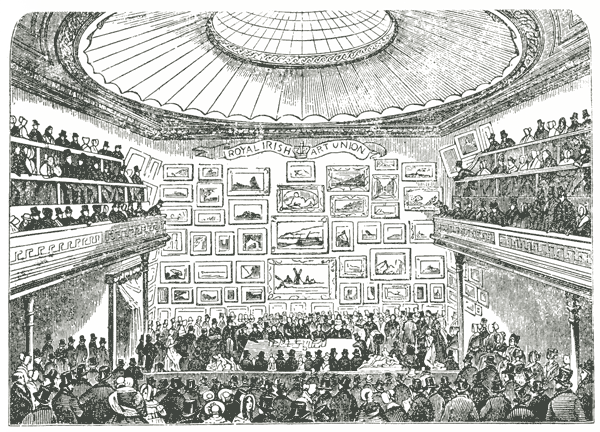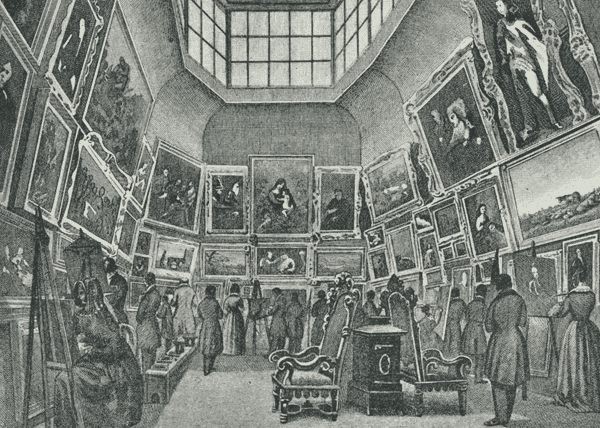The Royal Irish Art Union
From A Dictionary of Irish Artists 1913
At a meeting held in Dublin on 8th April, 1839, the Marquess of Ormonde in the chair, the Royal Irish Art Union was established "for the Encouragement of the Fine Arts in Ireland by the purchase of the Works of Living Artists exhibited in the Metropolis." At a general meeting of subscribers a committee of twenty-one members were chosen to select and purchase at the exhibition of the Royal Hibernian Academy "such works of art as are creditable to the talent and genius of the country." These works were distributed by lot as prizes among the subscribers, one chance being allowed for a guinea, two chances for two guineas, and so on; and every member was entitled to an engraving published by the Art Union. The committee held their meetings in the Royal Irish Institution, College Street. The Society set themselves to work to counteract the general apathy which existed in Ireland with regard to the Fine Arts, at a time when the exhibitions of the Royal Hibernian Academy were neglected, and artists found it impossible to obtain sale for their works. The Academy were unable to hold an exhibition in 1839, and during the four years preceding not a single work had been sold.

The Royal Irish Art Union; drawing of prizes in 1843
In 1840 the subscriptions to the Art Union amounted to £1,235. Out of this sum the Committee had Burton's drawing of "The Blind Girl at the Holy Well," engraved by Ryall, and purchased fifty-one pictures and drawings, as well as forty casts from Kirk's group of "The Young Champion," to the amount of £1,145 16s., to be distributed as prizes to the subscribers. They also resolved to appropriate £160 to be given as premiums to artists resident in Ireland, as follows:
1. For a Line Engraving on copper or steel £50
2. For an Etching or Mezzotint £25
3. Engraving on wood, 1st prize £10. Engraving on wood, 2nd prize £5
4. Lithographic drawing, 1st prize £10 Lithographic drawing, 2nd prize £5
5. A pair of Medal dies £25
6. Engraving on gem or hard stone, 1st prize £10. Engraving on gem or hard stone, 2nd prize £5
7. Model or cast in clay, plaster or wax, 1st prize £10. Model or cast in clay, plaster or wax, 2nd prize £5
The sums given in premiums were subsequently increased.
The first competition took place in 1842, when the following premiums were awarded:
Engraving, Etching, Wood-engraving.—None awarded.
Lithography.—Henry O'Neill, for the "Kerry Minstrel." W. F. Wakeman, extra prize for "Thomond Bridge, Limerick."
Pair of Medal Dies.—William Woodhouse, for his Medal of Dean Dawson.
Gem Engraving.—W. Ross, Belfast, for his "Dying Lion," on crystal.
Modelling.—Constantine Panormo, for "The Rescue."
In the following years the awards were:
1844
Engraving and Etching.—None.
Wood-engraving.—1st prize not awarded; 2nd prize, — Walker, Ordnance Survey Department.
Lithography.— 1st, Henry O'Neill, but disqualified owing to non-compliance with regulations; 2nd, G. V. Du Noyer.
Medals.—William Woodhouse, for Medal of Francis Johnston.
Gem Engraving.—Thomas Flavelle, of Kilkenny, for Head of C. K. Bushe on a bloodstone, and Judge Burton on a cornelian.
Modelling.—1st, Thomas Farrell, for groups of "Boys and Dog" and "Boys and Goat"; 2nd, J. R. Kirk, for "Statue of Andromeda."
Line Engraving.—James Peterkin, for "A Terrier, and a Rat caught in a Trap," after C. Grey.
Etching.—William Howis, jun.
Wood Engraving.—G. A. Hanlon, for Architectural Views after Petrie. Extra prizes to Mrs. Millard for her title-page to "The Spirit of the Nation," after F. W. Burton, and to W. Oldham for a Landscape.
Medals.—William Woodhouse, for his Medal of Edward Smyth. Extra prize to Isaac Parkes.
Gem Engraving.—W. C. Forster, for an intaglio of Richard Carmichael, M.D. Honourably mentioned, Thomas Flavelle and Thomas Badge.
Modelling.—Thomas Farrell, for "Nisus and Euryalus." Extra prize to J. H. Nelson for "Head of Sappho."
Drawing from Life.—Henry O'Neill, William Clarke, George Sharp, Hugh Talbot and William Connolly.
1845
Lithography.—1st, J. H. Lynch; 2nd, J. H. Burgess; 3rd, Henry O'Neill.
Gem Engraving.—W. C. Forster, for figure of "Andromeda" on a cornelian, after J. R. Kirk's statue.
Modelling.—James Farrell, for "The Pet Dove's Return." Extra prize to J. H. Nelson for "Venus Attiring."
Drawings from Life.—R. Fox, C. V. Foley, W. Nolan, Hugh Talbot, G. F. Clarke and L. K. Bradford.
Designs in Outline.—M. A. Hayes for "Savourneen Deelish"; S. Watson for "Illustrations of Irish History."
1846
Line Engraving.—George McCoy, for a Scene, after Edwin Hayes.
Wood Engraving.—G. A. Hanlon, W. Oldham.
Lithography.—J. H. Burgess, for "The Great Britain Steamer ashore in Dundrum Bay."
Gem Engraving.—W. C. Forster.
Modelling.—1st, William B. Kirk, for "Iris Ascending"; 2nd, Thomas Farrell, for "Young Bather Surprised, or Boy and Swan." Additional premium, F. Burnett, for group of "Child and Dog."
Medals.—William Woodhouse, for general excellence.
Composition in Outline.—S. Watson, for series of "Red Hugh O'Donnel."
1847
Line Engraving.—George McCoy.
Modelling.—Richard Barter, for "Venus and Cupid."
Among the large number of works purchased by the Art Union and given as prizes to its subscribers were:
1841. "The Connemara Toilette," by F. W. Burton, £168. "Roderick O'Conor's Castle," by W. Brocas," £30. "The Sportsman's Companion," by C. Grey, £35. Dublin Bay Lighthouse, by M. Kendrick, £36. Tired Out, by R. Rothwell, £47. Coriolanus, by John Tracey, £50.
1842. The Parting Gleam, by George Colomb, £80. The Lesson, by T. Bridgford, £70. Mary Queen of Scots' Farewell to France, by E. D. Leahy, £70. Emigrants Leaving Ireland, by W. Brocas, £60. Launce presenting his Dog to Lady Sylvia, by George Francis Mulvany, £50. Marchande de Roses, by W. H. Collier, £50.
1843. The Rescue, group in marble, by C. Panormo, £80. Andromeda, in marble, by J. R. Kirk, £70. Hermia and Helena, by W. Fisher, £60.
1844. Cup-Tossing, by N. J. Crowley, £75. The Shebeen House, by Catterson Smith, £50.
1845. The Young Mother's Pastime, by R. Rothwell, £120. St. Patrick Baptizing Aengus, by George Francis Mulvany, £80. The Last Stand of the 44th Regiment, by M. A. Hayes, £80. Nathan reproving David, by J. Harwood, £70. Child listening to Shell, marble, by J. R. Kirk, £60.
1846. Last Round of the Pilgrims at Clonmacnois, by G. Petrie, £150. The Greek Refugees, by W. Fisher, £120.
1847. The Creation of the Dimple, marble, by J. R. Kirk, £100. Invitation, Hesitation and Persuasion, by N. J. Crowley, £60. The Great Britain Steamer ashore in Dundrum Bay, by M. Kendrick, £60.
The efforts of the Art Union to awaken the public mind to an interest in the Fine Arts was successful; a steady increase took place in the number of landscape and genre pictures and of sculpture exhibited in the Academy, and during the four years following the establishment of the Union the receipts at the exhibitions amounted to £1,790 15s. as compared with £577 13s. the four years preceding. For the four years, 1835-1839, the purchases made in the Academy amounted to £1 10s., while in the first four years of the Art Union's operations, 1840-1843, the sales of pictures, etc., in the Academy reached the sum of £6,778 10s. expended by the Union, and £1,227 10s. expended by private purchasers.

The Royal Irish Art Union; drawing of prizes in 1843
Unfortunately, however, the original idea of encouraging native artists was departed from, and after the first two years the bulk of the purchases was from non-resident artists, a change which was widely resented. The Union expended an undue proportion of its funds upon engravings, and much dissatisfaction arose at the long delay in delivering the prints to subscribers. Subscriptions began to fall off. After 1847 it lingered on for a few years, and in 1851 the Royal Irish Art Union terminated its existence.
During the Society's seven years' active work the following pictures were engraved for presentation to subscribers:
1840. The Blind Girl at the Holy Well, by F. W. Burton; engraved by H. T. Ryall.
1841. The Young Mendicant's Noviciate, by Richard Rothwell; engraved by Samuel Sangster.
1842. A Peep into Futurity, by Daniel Maclise; engraved by Richard Golding. Owing to the engraver's illness the plate was not completed, and one of Turner's Ancient Italy substituted.
1843. The Arran Fisherman's Drowned Child, by F. W. Burton; engraved by F. Bacon.
1844. Belisarius, by Sir Martin Archer Shee; engraved by S. Sangster.
1845. Modern Italy, by J. M. W. Turner; engraved by Miller. This plate was substituted for Mulready's "Fight Interrupted," the production of which was prevented by the illness and death of the engraver, C. Fox.
1846. Fortune Telling by Cup-Tossing, by N. J. Crowley; engraved by Sharpe. The Limerick Piper, by J. P. Haverty; lithographed by J. S. Templeton. Savourneen Deelish, a series of outline drawings by M. A. Hayes; lithographed by J. H. Lynch. Egeria, engraved by W. Humphreys.
1847. The Village Festival; by Sir David Wilkie.
« Londonderry School of Art | Contents and Search | The National Art Union »
